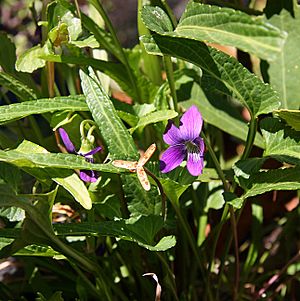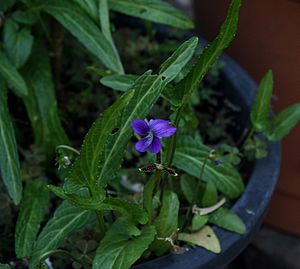Arrowhead violet facts for kids
Quick facts for kids Arrowhead violet |
|
|---|---|
 |
|
| Scientific classification | |
| Genus: |
Viola (plant)
|
| Species: |
betonicifolia
|
| Synonyms | |
|
Viola longiscapa (DC.) G.Don |
|
The Arrowhead Violet (Viola betonicifolia) is a beautiful small plant. People also call it the Showy Violet or Mountain Violet. It belongs to the Viola family, which includes many lovely flowers like pansies and other violets. You can find this plant growing naturally in places like India, Pakistan, and across eastern Australia, including Tasmania. It loves to grow in shady spots within forests.
Contents
Discovering the Arrowhead Violet
Who Named This Plant?
A long time ago, in 1817, an English plant expert named Sir James Edward Smith was the first to officially describe the Arrowhead Violet. He gave it the scientific name Viola betonicifolia. He also called it the "betony-leaved violet." Sir James Edward Smith wrote about it in a large book called Rees's Cyclopædia. He noted that this plant originally came from New South Wales, Australia.
Later, another botanist named George Bentham studied the plant. He confirmed that Viola betonicifolia was the correct and oldest name for this species.
What Does the Arrowhead Violet Look Like?
Leaves and Flowers
The Arrowhead Violet has special leaves that look like arrows. They are long and slender, growing up to about 6 centimeters (2.4 inches) long. These leaves grow directly from the base of the plant, as it doesn't have a tall stem. They are usually a bright, fresh green color.
In spring and summer, this plant shows off its amazing bright purple flowers. Each flower is about 1 to 1.5 centimeters (0.4 to 0.6 inches) wide. After the flowers bloom, small pale brown pods appear. These pods hold tiny, dark seeds inside.
Where Does the Arrowhead Violet Live?
Natural Homes of the Violet
You can find Viola betonicifolia in many different places. In Australia, it grows in Tasmania and across the eastern mainland. This includes states like South Australia, Victoria, New South Wales, and Queensland.
Beyond Australia, this violet also grows in Asia. It can be found as far west as India and Pakistan. No matter where it is, the Arrowhead Violet prefers to grow in shady areas, often found within forests.
How Does the Arrowhead Violet Help Nature?
Plants and Animals Working Together
The Arrowhead Violet plays an important role in its environment. Some caterpillars, like those of the Laced Fritillary butterfly (Argynnis hyperbius), love to eat this plant. It's their food!
The flowers of the Arrowhead Violet are also important for other insects. Large or Common Grass Yellow butterflies (Eurema hecabe) help pollinate the flowers. This means they carry pollen from one flower to another, helping the plant make seeds.
Sadly, some places where the Arrowhead Violet grows, like coastal swamps in New South Wales, have been changed by people. This has made it harder for the Laced Fritillary butterfly to survive in that area.
Growing Your Own Arrowhead Violet
Caring for This Easy Plant
The Arrowhead Violet is a very easy plant to grow in a garden. It can adapt to different types of soil. The most important things it needs are enough moisture and at least half shade. It actually prefers more shade than sun.
This plant is great for rock gardens. If you plant it in soil that holds moisture well, it can grow quite strongly. It forms clumps that can spread out to about 30 centimeters (12 inches) wide. The Arrowhead Violet also spreads its own seeds, so new plants can pop up easily!


